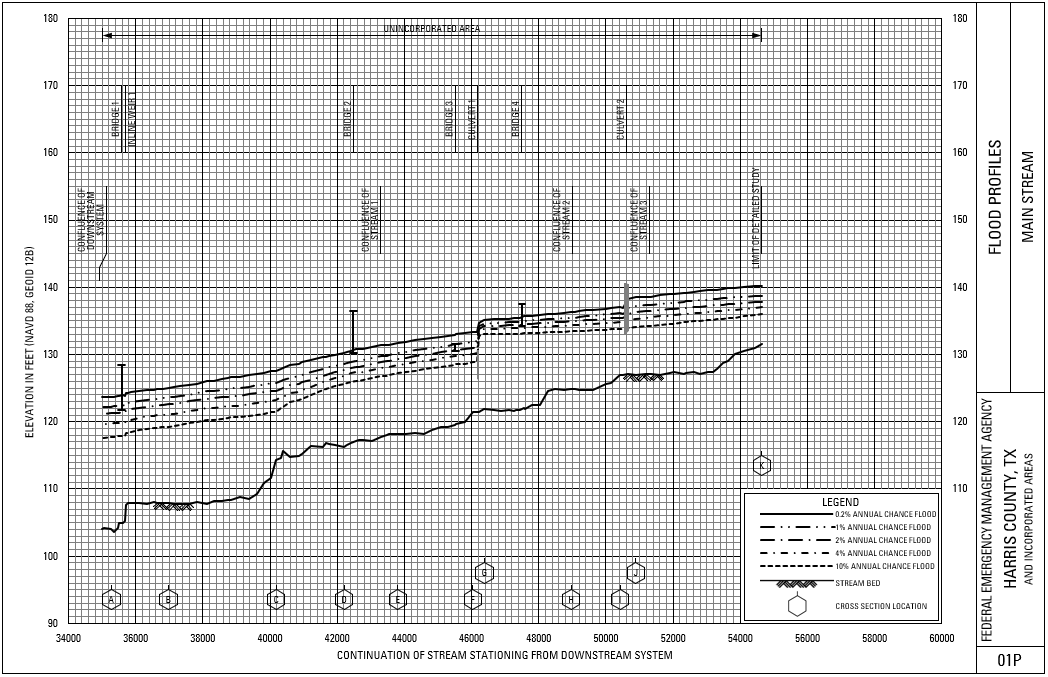FIS Profile Tool for Unsteady HEC-RAS Models Assists MAAPnext Project
As one of seven engineering consulting firms assisting Harris County Flood Control District with its flood resiliency MAAPnext program, Freese and Nichols developed a tool for creating and updating hydraulic profiles of streams that is faster and easier to use than the traditional method.
This Excel-based tool for Flood Insurance Study (FIS) profiles solved a significant problem for HCFCD because the traditional method does not support new modeling methodology. The new method supported HCFCD in meeting a tight schedule for delivering the overall project to FEMA, ultimately helping produce final products with less effort and budget compared to the traditional process, while maintaining or improving quality and functionality.
The development of this tool recently won a Horizon Award, a quarterly award at Freese and Nichols given to projects that encapsulate our culture of innovation.
Innovative Aspects
- The “one-stop-shop” Excel program significantly reduces users’ time and effort in creating profiles for hydraulic models when compared to the previous process using FEMA’s RASPLOT program.
- This new tool is the first of its kind, as the traditional method and program (RASPLOT) does not support the new 1D/2D modeling methodology used in MAAPnext.
- The new tool will aid in HCFCD’s Letter of Map Revision (LOMR) Delegation program, benefitting the district beyond the scope of the MAAPnext project.
- The new tool included a significant number of value-added items to greatly improve the user’s experience and speed compared to the traditional process.
- Given a compressed schedule to deliver the overall project to FEMA, the tool helped deliver final products to HCFCD with less effort and budget compared to the traditional process, while maintaining or improving quality.

MAAPnext Background
With Harris County’s recent history of catastrophic flooding, HCFCD partnered with FEMA on MAAPnext — the Modeling, Assessment and Awareness Project — a multimillion-dollar countywide initiative to produce the nation’s most comprehensive set of flood hazard maps and flood risk data.
The firms working on MAAPnext were tasked with creating all-new hydrologic and 1D/2D hydraulic models that simulate flooding, ultimately generating new detailed floodplain maps and flood risk data for the county. One component of this massive undertaking included updating hydraulic profiles in the Flood Insurance Study (FIS) for every stream modeled. FEMA and regulatory entities use these FIS profiles when they need a more accurate estimate of a flood elevation than a Flood Insurance Rate Map (FIRM) provides.
The traditional approach for creating profiles uses FEMA’s RASPLOT program and its CAD-based companion, DXF editor. However, RASPLOT is only compatible with outdated steady-state 1D modeling, while MAAPnext uses more advanced, complex and detailed unsteady 1D/2D modeling. Initial testing of a workaround solution with the traditional process proved to be lengthy and cumbersome. Given the scale of MAAPnext, known issues would have significantly compounded. Instead of manipulating the model data to fit the previous method, a new tool was developed by Stormwater Engineer Mat Leclair to work seamlessly with the new model data and produce the same product. HCFCD and its project management team for MAAPnext agreed the new tool was the best solution. Freese and Nichols also provided support when the process was reviewed by FEMA’s contractors, and we supported other consulting firms in MAAPnext.
How the New Tool Added Value
During development, three key goals were used for improving efficiency and to add value:
- Replicating all of RASPLOT’s functions in a single template program following FEMA guidance and standards to produce a product that mimics the RASPLOT output
- Standardizing processes to produce consistent results for a larger user base and minimize the amount of manual data entry
- Prioritizing functionality and speed with the use of dynamic references and auto-adjusting visuals to improve on the traditional method
The “one-stop-shop” set up in conjunction with the use of dynamic references work in tandem, allowing the user to see the effects of their changes “on-the-fly” for quick adjustments and reduced time in creating profiles. Items shown on the profile pages include hidden built-in standard adjustments for a variety of different scenarios, which also decreases the number of manual changes needed from the user. Visuals also were created that show the data in preset viewing windows and auto-update when data is changed, allowing the user to see the updates on the same tab.
Finally, a critical component in the tool’s development was standardizing and prioritizing speed. The overall project uses seven engineering firms and potential future users, so each person might input data in a variety of ways. Freese and Nichols created a structured template that standardized a variety of items and created VBA coding to automatically extract data in a systematic way to produce consistent and repeatable results. Additionally, due to the size of the models and associated data, certain methods were chosen for the coding that prioritized speed of data extraction, reducing the delay in processes. A guided template structure and accompanying user guide also lead the user from start to finish with ease. All of these items reduced the amount of potential error, drastically reduced the amount of time and effort, and improved the overall experience in creating profiles.
To illustrate improvements made by the tool, testing performed showed that the time to create a profile on a relatively small stream could be reduced from 1.5 hours to just 16 minutes. Over time, this becomes even less as a user gets more familiar with the tool. Additionally, future edits and changes take a matter of minutes compared to the traditional process.

